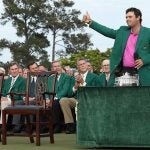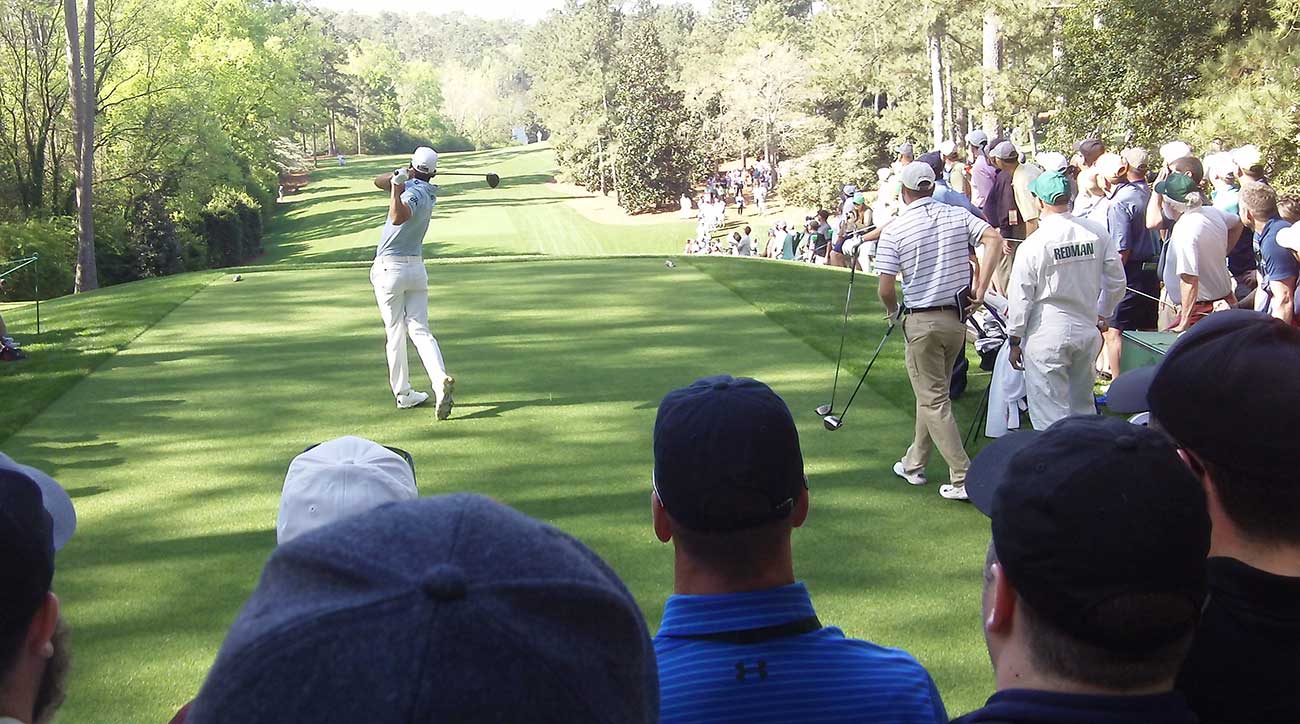The 82nd Masters wrapped up Sunday night with Patrick Reed winning his first career major title and slipping on a new green jacket. But the week leading up to Sunday’s dramatic conclusion was full of thrills. Our staff reflects on their most memorable moments in our lessons from Augusta.
A REUNION IN AUGUSTA
By Michael Bamberger
I had a guest at the Golf Writers dinner Wednesday night, Peg Palmer, the older of Winnie and Arnold Palmer’s two children, both now grown women deep into middle age. The last time Peg had been to Augusta was in 2004, when her father played in his final Masters. That event left Peg hurt, because her father, in his public remarks, did not acknowledge her mother, who had died five years earlier and was a significant part of Arnold’s Masters history. At last year’s tournament, when Billy Payne offered a first-tee tribute to the man often called The King, Peg was not there. Her invitation never got to her, but more to the point, she knew that today’s tournament was not the tournament from her girlhood, in the 1960s and ‘70s. As she noted to me, “The people change.” She wasn’t that eager to go.
So I was surprised when she accepted my invitation to the GWAA’s Wednesday night dinner, but she did and she sat with my fellow typists and editors at Table 29 in the cavernous ballroom of the Savannah River Rapids Pavilion on the outskirts of the city, not far from where Patrick Reed’s parents live. (I had written a story about Peg last year and was getting some wood for it but the story really is hers.) My favorite moment of Masters week 2018 came when Dan Jenkins, who wrote up many of Arnold’s wins and likely (golf being golf) more of his losses, walked by our table. Jenkins, Arnold’s age almost exactly — he’s pushing 90 — remains, by far, the most distinctive voice the game has. Distinctive appearance, too. Tall, now slender again (with age), white-haired, big glasses that help him see things others don’t. Plus, his ears.
Peg is the opposite of a glad-hander but she seized the moment, stopped Dan in his loafered tracks, shook his hand, introduced herself — or reintroduced herself — and they talked for maybe a minute. What they said I do not know but they were both smiling. They both seemed happy.

By email, Peg sent me something Jenkins had written about her father:
“This is true, I think. He IS the most immeasurable of all golf champions. But this is not entirely true because of all that he has won, or because of that mysterious fury with which he has managed to rally himself. It is partly because of the nobility he has brought to losing. And more than anything, it is true because of the pure, unmixed joy he has brought to trying.
“He has been, after all, the doggedest victim of us all.”
Well, for starters, you could spend the rest of your life trying to capture an athlete’s spirit in two short ‘graphs and never do better than that. My friend Jaime Diaz once wrote of those half-dozen sentences, “I wonder how thrilling it must have been to write those words, to finish the greatest golf book ever with the greatest kicker.” The book is The Dogged Victims of Inexorable Fate. The title itself comes from something Bobby Jones once wrote: “On the golf course, a man may be the dogged victim of inexorable fate, be struck down by an appalling stroke of tragedy, become the hero of unbelievable melodrama, or the clown in a sidesplitting comedy — any of these within a few hours, and all without having to bury a corpse or repair a tangled personality.”
This is true, I think. How good is that?
One of the things I like most about golf in general and the Masters in particular is that it slows time, sometimes stops it, occasionally reverses it. Patrick Reed had to make a 4 on the last just as Sandy Lyle once did, as Jack Nicklaus once did, as Ben Hogan once did, etc. For that minute Peg and Jenkins were together, time slowed, then stopped and briefly reversed. Then Dan went back to his seat, one table over, and Peg did the same. Dan lives in Fort Worth and Peg in Raleigh. Maybe they’ll see each other again someday, but it’s not likely.
MILLION-DOLLAR VIEW
By Jeff Ritter
Like many of us seated in Augusta’s opulent press center, every year I’m fortunate enough to cover the Masters I get out and take at least one full lap around the course.
And every year I manage to somehow stumble upon a new spot I never noticed. This year, on a gorgeous Masters Monday, I made a long, lazy loop out toward Amen Corner and reached the 11th fairway. I turned back and realized that in all these years I’d never made the steep 50-yard hike up the ridge to the 11th tee box. (OK, real talk: it’s probably 30 yards. And it’s more of a mound than a “ridge.” But it’s definitely uphill.)
I crested the hill, stood behind the box on a warm afternoon and was once again blown away by a fresh angle of Augusta National. In front of me, Rafa Cabrera-Bello sent a tee shot flying. The crowd buzzed. The air smelled faintly of cigar smoke. There’s more dogleg to the hole than I ever realized. I’ll be making a return visit next year.

THE ODD COUPLE
By Alan Bastable
Among my favorite Masters traditions is the ritual of young’uns pegging it with players who should be playing shuffleboard in Boca, not a major at Augusta. In no other sport do athletes two-plus generations apart compete side by side on so grand a stage. Which is why the 11 a.m. third-round pairing of Doug Ghim and Bernhard Langer caught my eye.
Ghim is 21. An Illinois native, he plays at the University of Texas and punched his ticket to Augusta by finishing runner-up at the 2017 U.S. Amateur. Ghim is earnest and humble and respectful, or at least he was in the 10 or so minutes we spent chatting outside the ANGC pro shop on Saturday afternoon. Not once did he refer to his partner as Bernhard. Always Mr. Langer.
Mr. Langer, you already know: 60-year-old German in the body of a 36-year-old, winner of two green coats, Terminator of the senior circuit. Ghim didn’t watch either of Mr. Langer’s Masters wins (1985 and ’93), not because he wasn’t interested in golf yet, but because he wasn’t born yet. When I caught up with Ghim, he had just signed for a two-over 74 in taxing conditions. Mr. Langer had beat him by three.
“Man, Mr. Langer still has lots of game,” Ghim said. Mr. Langer certainly didn’t overpower Augusta, requiring long irons and hybrids into many of the greens, and he rarely fired at sticks, but he knew precisely where to miss, Ghim noted, avoiding Augusta’s landmines and leaving himself straightforward chips and putts below the hole. Ghim was impressed by more than just Mr. Langer’s course management.
“I played with a lot of nice people this week, but Mr. Langer might have been the nicest one,” Ghim said. On several occasions, Mr. Langer played out of turn to give his young partner more time to prepare for a shot. On another occasion, Mr. Langer approached Ghim’s father, Jeff, who was on the bag for his son. “You must be one proud father,” Mr. Langer said.
When Ghim holed out for a bogey 5 at 18, Mr. Langer shook his hand and looked him square in the eye. “Good playing,” Mr. Langer said, as Ghim recalled it. “You should be proud of yourself. Not many people can say they won low amateur honors here. Good luck with the rest of your career. I sincerely hope I see you again very soon.”
Presumably the feeling was mutual.

A PATRON’S DUTY
By Jess Marksbury
Fan behavior at golf events has been a hot topic lately, and for good reason. What used to be an occasional shouted exclamation near the end of a round — “Mashed potatoes!” “Get in the hole!” “You da man!” “Dilly, dilly!” — has suddenly become the norm, and incidents of interruption that were often dismissed as isolated to rowdy events like the Waste Management Phoenix Open are now occurring with alarming frequency. Justin Thomas made headlines when he had a fan ejected for excessive negativity during the final round of the Honda Classic this year, and even perennial fan favorite Rory McIlroy suggested limiting alcohol to curb fan rowdiness.
Here at the Masters, such delinquencies are nonexistent, because the club rules with an iron fist. There is no running, electronic devices are prohibited, and if you decided to yell a derogatory phrase at a player, you’ll face a stiff penalty: immediate removal from the grounds. Some people chafe at the idea of Augusta’s long list of dos and don’ts, but not me. Call me old-fashioned, but I appreciate watching golf in an environment based on mutual respect. I’m not sure why some spectators believe that, by virtue of buying a ticket to a sporting event, they have permission to do or say whatever they want to the competing athletes because, hey, “Welcome to sports.”
I don’t buy that. Bad fan behavior is becoming more and more noticeable, and it’s starting to mar Sunday afternoons on the PGA Tour. At the Masters everyone feels the weight of the epic privilege it is to merely be on property, which is how the vibe at every tournament should be. My hope for golf’s future: let’s treat every round — and player — with the reverence we all feel for Augusta National.
AN AUGUSTA ROOKIE’S FIRST IMPRESSIONS
By Dylan Dethier
An open area, about 200 by 200 yards, separates the 8th tee and 9th green at Augusta National. There’s no real playable purpose to the land now (it was an old driving range); it would require a block slice from the 8th tee or a shank from the 9th fairway to end up there. But it’s mowed down anyway to fairway length, just because.
In a lot of ways that stretch of grass was emblematic of my first impressions of Augusta. When I first walked onto property I had to check the ground by my feet to make sure it wasn’t turf (it wasn’t). It should be no surprise to any casual viewer that things at Augusta are immaculate, but I was struck by the visuals of the place: it stretches out before you, hole after hole after hole, connected by tightly mown fairway and segmented only by tall, tightly trimmed pines.
I guess that’s what was most striking about being there in person versus TV — Augusta isn’t just a series of holes, which is how it comes off in the broadcast. Those holes are connected and related in interesting ways across a massive, sprawling property. The effect made the place feel both bigger and smaller than I expected. Some stuff is surprising close together: the greens on 9 and 18, for example, or the way 15 and 16 stack right on top of each other. But there’s an enormity to it, too, that comes through from standing at the clubhouse and trying to see down to Amen Corner (I tried; you can’t). What you can see is people walking around like they’re in some sort of national park, taking in the trees, and flowers, and perfectly manicured grass.






